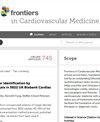Cardiovascular disease in thymic cancer patients
IF 2.8
3区 医学
Q2 CARDIAC & CARDIOVASCULAR SYSTEMS
引用次数: 0
Abstract
IntroductionCancer patients may have increased risk for adverse cardiac events, but our understanding of cardiovascular risk in thymic cancer patients is not clear. We sought to characterize baseline cardiometabolic risk factors before thymic cancer diagnosis and the potential association between cancer treatment and subsequent cardiac events.MethodsThis was a retrospective cohort study evaluating patients with thymic cancer from 2003 to 2020 compared to age- and sex-matched controls without cancer. Baseline cardiovascular risk factors, cancer characteristics, and incidence of cardiac events were collected from the health information exchange. Multivariable regression was used to examine the impact of cardiovascular risk factors and cancer therapies.ResultsWe compared 296 patients with pathology-confirmed thymic cancer to 2,960 noncancer controls. Prior to cancer diagnosis, thymic cancer patients (TCPs) had lower prevalence of hypertension, dyslipidemia, and diabetes mellitus and similar rates of obesity, tobacco use, and pre-existing cardiovascular disease (CVD) compared to controls. After diagnosis, high-risk TCPs (>2 cardiovascular risk factors or pre-existing CVD) had higher risk for cardiac events (HR 3.73, 95% CI 2.88–4.83,胸腺癌患者的心血管疾病
导言癌症患者发生不良心脏事件的风险可能会增加,但我们对胸腺癌患者的心血管风险尚不清楚。我们试图描述胸腺癌诊断前的基线心血管代谢风险因素以及癌症治疗与后续心脏事件之间的潜在关联。方法这是一项回顾性队列研究,评估了 2003 年至 2020 年期间胸腺癌患者与年龄和性别匹配的非癌症对照组的对比情况。基线心血管风险因素、癌症特征和心脏事件发生率均通过健康信息交换系统收集。结果我们将296名病理确诊的胸腺癌患者与2960名非癌症对照者进行了比较。与对照组相比,胸腺癌患者(TCPs)在癌症确诊前的高血压、血脂异常和糖尿病患病率较低,肥胖、吸烟和原有心血管疾病(CVD)患病率相似。确诊后,高风险 TCPs(>2 个心血管风险因素或原有心血管疾病)发生心脏事件的风险更高(HR 3.73,95% CI 2.88-4.83,p< 0.001)。在确诊后的头 3 年,TCPs 的心脏事件发生率更高(HR 1.38,95% CI 1.01-1.87,p = 0.042)。接受放疗或化疗的高危 TCP 患者发生心脏事件的风险更高(HR 4.99,95% CI 2.30-10.81,pamp;lt; 0.001;HR 6.24,95% CI 2.84-13.72,pamp;lt; 0.001)。有多种心血管风险因素的患者在接受放疗或化疗时发生心脏事件的几率更高。
本文章由计算机程序翻译,如有差异,请以英文原文为准。
求助全文
约1分钟内获得全文
求助全文
来源期刊

Frontiers in Cardiovascular Medicine
Medicine-Cardiology and Cardiovascular Medicine
CiteScore
3.80
自引率
11.10%
发文量
3529
审稿时长
14 weeks
期刊介绍:
Frontiers? Which frontiers? Where exactly are the frontiers of cardiovascular medicine? And who should be defining these frontiers?
At Frontiers in Cardiovascular Medicine we believe it is worth being curious to foresee and explore beyond the current frontiers. In other words, we would like, through the articles published by our community journal Frontiers in Cardiovascular Medicine, to anticipate the future of cardiovascular medicine, and thus better prevent cardiovascular disorders and improve therapeutic options and outcomes of our patients.
 求助内容:
求助内容: 应助结果提醒方式:
应助结果提醒方式:


